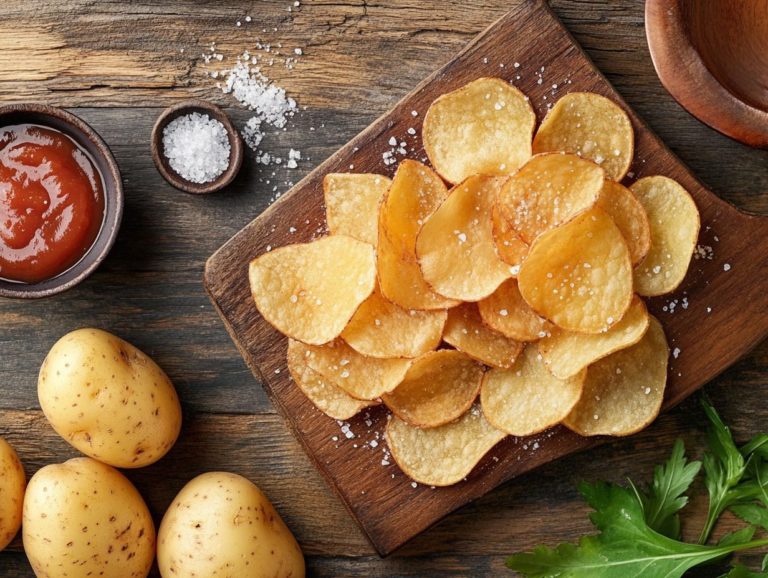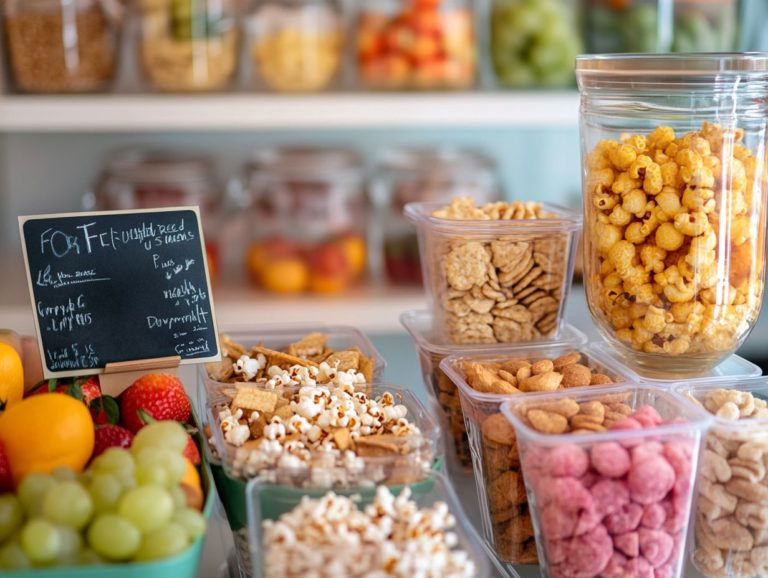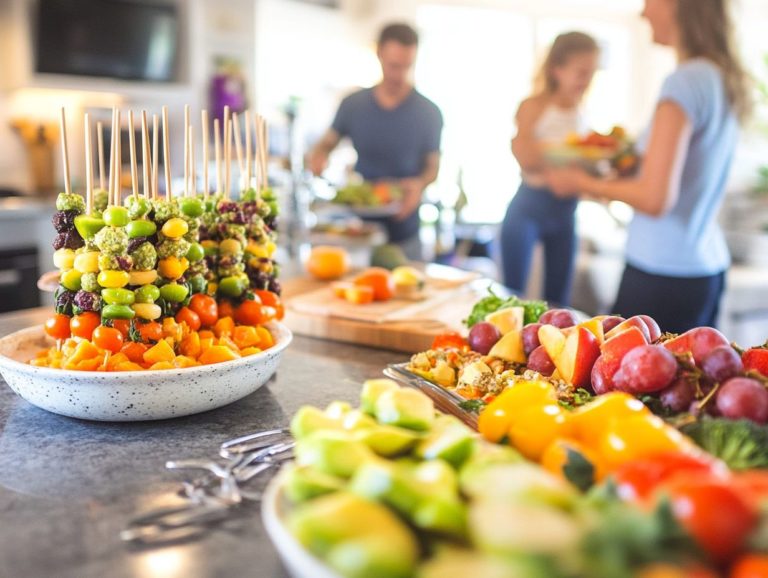How to Bake Gluten-Free Muffins: A Step-by-Step Guide
If you’re intrigued by gluten-free baking, gluten-free muffins are a delightful place to begin your culinary journey. These muffins are easy to prepare and perfect for experimenting with various mix-ins options. Get ready to create delicious muffins that will impress everyone!
In this exploration, you’ll discover what gluten-free muffins are all about, the benefits of incorporating them into your diet, and the essential ingredients you’ll need to create them, including tips for achieving tall muffin tops.
Whether you’re an experienced baker or just starting to dabble in the kitchen, the straightforward, step-by-step guide will ensure that the process is not only easy but also enjoyable.
Common baking pitfalls will be addressed. This will empower you to bake with confidence. You’ll learn secret tricks to avoid dense pockets and ensure your muffins are light and fluffy. Prepare to whip up some truly scrumptious treats!
Contents
- Key Takeaways:
- What Are Gluten-Free Muffins?
- Why Bake Gluten-Free Muffins?
- Ingredients for Gluten-Free Muffins
- Step-by-Step Guide to Baking Gluten-Free Muffins
- How to Store and Reheat Gluten-Free Muffins
- Troubleshooting Common Problems with Gluten-Free Muffins
- Frequently Asked Questions
- What are the benefits of using gluten-free ingredients when baking muffins?
- What are some common substitutes for wheat flour in gluten-free muffin recipes?
- How can I ensure that my gluten-free muffins turn out moist and fluffy?
- Can I use regular muffin recipes and simply substitute gluten-free flour?
- How important is it to use gluten-free baking equipment and utensils?
- Are there any add-ins or toppings that pair well with gluten-free muffins?
Key Takeaways:
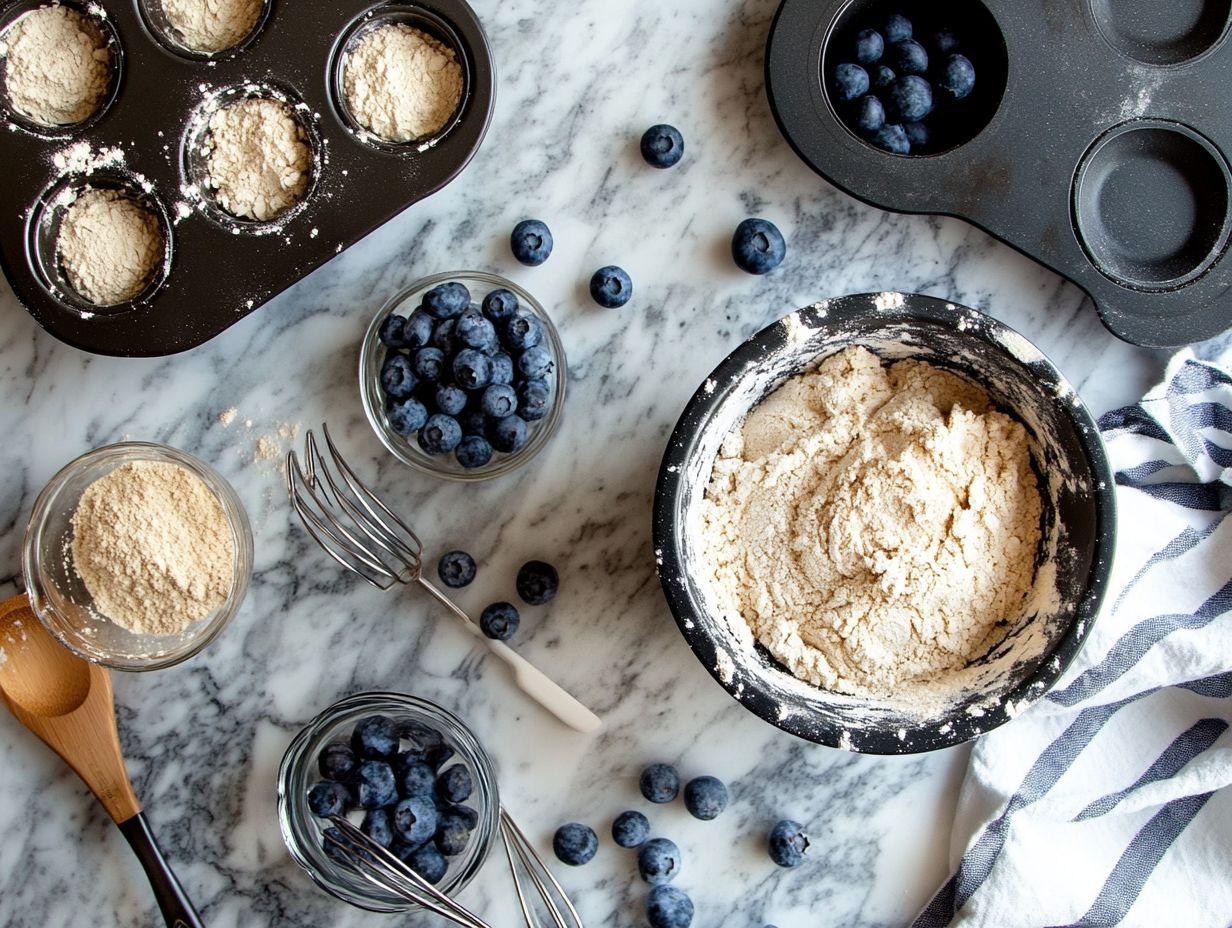
- Gluten-free muffins are a delicious and healthy alternative to traditional muffins and can be enjoyed by everyone. Try different muffin recipes like gluten-free blueberry or gluten-free pumpkin to keep things exciting.
- Baking gluten-free muffins offers benefits like improved digestion and more nutrients. They also cater to various dietary needs, like dairy-free options.
- To make perfect gluten-free muffins, use a combination of essential ingredients and experiment with optional additions for added flavor and texture.
What Are Gluten-Free Muffins?
Gluten-free muffins present a delicious and versatile option for those adhering to a gluten-free lifestyle. These delightful treats can be crafted using an array of premium baking flours, such as almond and coconut flour, expertly combined with ingredients like baking powder, whole milk yogurt, or almond milk yogurt, and coconut oil. The result is a light, fluffy texture paired with a moist, flavorful taste that is truly satisfying.
With the right recipe in hand, you can indulge in scrumptious gluten-free muffins that prove flavor need not be compromised.
Why Bake Gluten-Free Muffins?
Baking gluten-free muffins presents a delightful opportunity to explore a vast array of flavors and health benefits, making it an enticing choice for home bakers and individuals following a gluten-free lifestyle. Whether you’re using a classic muffin recipe or experimenting with gluten-free banana variations, the possibilities are endless.
These simple yet versatile treats invite your creativity in the kitchen, allowing you to experiment with an assortment of mix-ins, from plump blueberries to indulgent chocolate chips, or even shredded apples and ground cinnamon for added flavor. As you embark on this baking adventure, you ll discover not only delectable flavors but also nourishing alternatives that perfectly align with your health-conscious choices.
Benefits of a Gluten-Free Diet
The gluten-free diet primarily caters to those with celiac disease (an autoimmune disorder that affects the small intestine) or gluten sensitivity (a condition that can cause discomfort after consuming gluten). However, it can also enhance digestion and energy levels for anyone embracing this lifestyle. By eliminating gluten-containing foods, you may find yourself experiencing fewer digestive issues, increased energy, and a more balanced diet.
This makes the gluten-free approach not just a necessity for some but an appealing choice for many, as showcased in delightful recipes like gluten-free muffins and other baked goods. Transitioning to a gluten-free lifestyle often encourages a more mindful selection of whole, nutrient-rich foods, which can significantly enhance your overall well-being.
As you make this dietary shift, you might notice that uncomfortable bloating and gastrointestinal discomfort become a thing of the past, replaced by a refreshing boost of energy throughout your day. Incorporating gluten-free muffins into your diet, often made with wholesome ingredients such as almond flour or oats, can serve as a nourishing snack that fuels your body without the drawbacks associated with gluten-rich products. This shift not only improves your health but may also inspire you to explore a wider array of food options, ultimately promoting a healthier lifestyle overall.
Ingredients for Gluten-Free Muffins
Creating mouthwatering gluten-free muffins begins with your choice of ingredients, which not only guarantee a delightful outcome but also meet specific dietary needs. Essential components like gluten-free baking flour, coconut oil, whole milk yogurt, or dairy-free yogurt, and baking powder come together beautifully, delivering the perfect texture and flavor.
Meanwhile, optional additions such as fresh fruit, like fresh blueberries or shredded apples, chocolate chips, or nuts elevate the muffin experience to a whole new level. Grasping the role of these ingredients is key to achieving the ultimate gluten-free muffin perfection.
What Are the Essential Ingredients for Gluten-Free Muffins?
When you bake gluten-free muffins, certain essential ingredients are key to achieving that perfect texture, flavor, and moisture you crave. Start with high-quality gluten-free baking flour as your foundation, then add baking powder to ensure those muffins rise beautifully. Don’t forget to use almond flour or other premium baking flours for a superior texture.
Incorporate coconut oil for richness and moisture, while whole milk yogurt or almond milk yogurt contributes to that light, fluffy crumb you desire. Don t forget the sugar it not only sweetens but also aids in browning, transforming your muffins into delightful treats. You can also use raw sugar for a different flavor profile.
Incorporating eggs into your mixture is vital; they bind everything together, resulting in a cohesive and tender muffin. If you’re looking for a touch of flavor contrast, a pinch of salt is crucial to balance the sweetness and enhance the overall taste.
Consider adding vanilla extract for a warm, inviting aroma that elevates the sensory experience of your baked goods. If you re feeling adventurous, mix in fresh fruits or chocolate chips to introduce additional flavors and textures, making each bite even more enjoyable.
By carefully selecting and combining these ingredients, your muffins will not only be gluten-free but also a delightful baked good that everyone can savor.
What Are Some Optional Ingredients for Gluten-Free Muffins?
To elevate your gluten-free muffins beyond the basics, consider exploring a delightful array of optional ingredients that can bring an exciting burst of flavor, texture, and nutritional value to your creations. Adding a crumb topping, for example, can provide a satisfying crunch.
Think about mixing in fresh fruits like succulent blueberries or shredded apples, alongside indulgent chocolate chips and an assortment of nuts. Adding spices such as fragrant ground cinnamon or a splash of lemon juice can truly enhance the flavor profile, making each batch a unique delight.
If you’re in the mood for an extra layer of richness, a scoop of creamy nut butter can do wonders. It not only enhances the moistness of the muffins but also infuses them with a delightful nutty taste. You might also consider adding poppyseeds for a subtle crunch and additional flavor.
You might also want to incorporate seeds like chia or flax for a healthy crunch, giving your muffins a boost of omega-3 fatty acids. And don t overlook shredded coconut, which adds a touch of tropical sweetness that s hard to resist. Storing your muffins in an air-tight container will keep them fresh longer.
For a refreshing twist, consider adding citrus zest from lemons or oranges to invigorate your muffins, making them bright and lively. Ultimately, these optional ingredients will not only set your creations apart but also cater to a variety of taste preferences, ensuring that your gluten-free muffins are a hit with everyone. For quick snacks, you might even try turning your batter into a microwave muffin for a speedy treat.
Step-by-Step Guide to Baking Gluten-Free Muffins

Baking gluten-free muffins is an effortlessly enjoyable endeavor that anyone can master with just a few simple steps. Start by preheating your oven and gathering all your ingredients to create the ideal foundation for a delightful muffin batter. Be sure to use a reliable recipe guide to help you through the process.
This comprehensive step-by-step guide will walk you through every essential aspect of the baking process, from blending the dry and wet ingredients to filling the muffin tin and finding the perfect baking time. With each stage, you’ll be closer to enjoying those delicious muffins you’ve been dreaming of. Don t forget to cool your muffins on a cooling rack to maintain their texture.
Step 1: Prepare Your Ingredients and Equipment
The first step in your journey to baking gluten-free muffins is to gather all your ingredients and equipment. Begin by preheating your oven to the desired temperature. Prepare your mixing bowl, muffin tin, and kitchen scoop, which will make portioning the muffin batter a breeze.
Use high-quality flour and ingredients to ensure the best results. It’s crucial to organize your ingredients by measuring out flour, sugar, and any delightful mix-ins like nuts or fruits ahead of time. A clutter-free workspace significantly enhances your efficiency throughout the baking process. Keep your wet ingredients, such as whipped eggs and yogurt, separate from the dry ingredients until you’re ready to mix.
Ensure your tools are at the ready whisks and spatulas included to avoid last-minute scrambles and potential mishaps. Consider using small containers or bowls to keep everything within sight; this saves you time and minimizes the risk of overlooking essential ingredients. Having a well-organized setup makes it easier to follow your recipe tips and ensures a smooth baking experience.
Get ready for baking success by preparing your environment now! This well-prepared environment allows you to focus on crafting those delectable gluten-free muffins without unnecessary distractions.
Step 2: Mix Dry Ingredients
In this step, you ll blend all the dry ingredients to create a perfectly balanced foundation for your gluten-free muffins. Gather your gluten-free baking flour, baking powder, baking soda, kosher salt, and just a pinch of xanthan gum in a mixing bowl. Whisk them together thoroughly to ensure they are evenly distributed.
Mixing the dry ingredients carefully is crucial, as it directly impacts the texture and rise of your muffins. When these dry ingredients are properly mixed, the leavening agents can activate as soon as moisture is added, resulting in a light and airy final product. If the dry ingredients aren t adequately combined, you risk uneven rising, which can create dense pockets and ruin the delightful, fluffy experience you expect from muffins. Properly blending the ingredients also helps in achieving the perfect crumb topping for added texture.
Keep in mind that achieving a harmonious blend enhances the flavor and plays a significant role in the appealing structure that leads to successful gluten-free baking.
Step 3: Mix Wet Ingredients
Next, direct your attention to the wet ingredients, as they are essential for infusing moisture and flavor into your gluten-free muffins. In a separate mixing bowl, whisk together the yogurt, melted coconut oil, and whipped eggs until well combined and smooth. This creamy mix boosts your muffin batter.
These choices of wet ingredients not only contribute to the overall texture but also impart essential flavors that elevate the final product. The yogurt brings a tangy richness and moisture that keeps the muffins tender, while the melted coconut oil adds a subtle sweetness and helps bind everything together. Whipped eggs introduce a delightful airiness, allowing for a lighter crumb.
As you combine these ingredients, be sure to whisk vigorously to achieve a homogenous blend. This ensures that every muffin is packed with the same delightful taste and moisture. Achieving this balance is crucial for a successful baking experience and will undoubtedly make your muffins a standout treat.
In conclusion, baking gluten-free muffins is a rewarding experience that allows for creativity and experimentation. Don’t hesitate to try different flavors and ingredients. Enjoy the process and savor the delicious results!
Combine Wet and Dry Ingredients to Make Muffin Batter
Once you have your wet and dry ingredients prepped, it s time to unite them to create the muffin batter, which is key to achieving that perfect consistency. Gently pour the wet ingredients into the bowl with the dry ingredients, stirring carefully until just combined. Be mindful not to overmix, as this can result in dense muffins.
Achieving the right balance in texture is essential. Keep a few flour streaks visible as you blend. This will help your muffins stay light and airy, ultimately delivering that irresistible fluffy bite. Opt for a spatula or wooden spoon instead of an electric mixer; this gives you better control over the process. The batter should feel cohesive yet slightly lumpy, inviting a delightful texture that will bake to perfection.
Combining the ingredients properly without overhandling ensures that your muffins rise beautifully in the oven.
Add Optional Ingredients
Once you’ve prepared the muffin batter, it’s time to elevate the flavor by adding ingredients that will make your gluten-free muffins truly delightful. Consider adding chocolate chips, fresh blueberries, or crunchy nuts, along with aromatic spices like ground cinnamon to enhance the taste and texture of your muffins.
Shredded coconut is another great option for a tropical flair, or you can add dried fruits such as cranberries and apricots for a touch of sweetness. If you’re inclined to introduce a nutritious twist, think about incorporating flaxseeds or chia seeds. These not only boost health benefits but also introduce an intriguing texture.
For those who appreciate a savory note, consider adding cheese or fresh herbs to create a uniquely delightful muffin experience. The possibilities are genuinely endless, inviting you to experiment and discover combinations that align perfectly with your personal taste preferences!
Fill Muffin Cups and Bake
The final step in your muffin-making journey is to fill those cups with your batter and bake them to perfection. Grab a kitchen scoop and evenly distribute the batter into the muffin tin, filling each cup about two-thirds full. Then, slide them into a preheated oven, where they will transform into golden brown delights! Keep a toothpick handy; when it comes out clean, you know they’re done.
Monitoring the baking time is essential typically, muffins take around 18 to 22 minutes to reach that ideal state. However, it’s wise to keep a close watch during the last few minutes, as every oven has its quirks. For an even bake, consider rotating the muffin tin halfway through. Once your muffins are beautifully baked, remove them from the oven and allow them to cool in the pan for about five minutes before transferring them to a wire rack.
This cooling period is crucial; it helps the muffins set and prevents any unpleasant sogginess. When it’s time to store your masterpieces, place the cooled muffins in an airtight container. They will keep wonderfully for up to three days at room temperature, or you can freeze them for longer preservation ideal for whenever those cravings strike!
How to Store and Reheat Gluten-Free Muffins
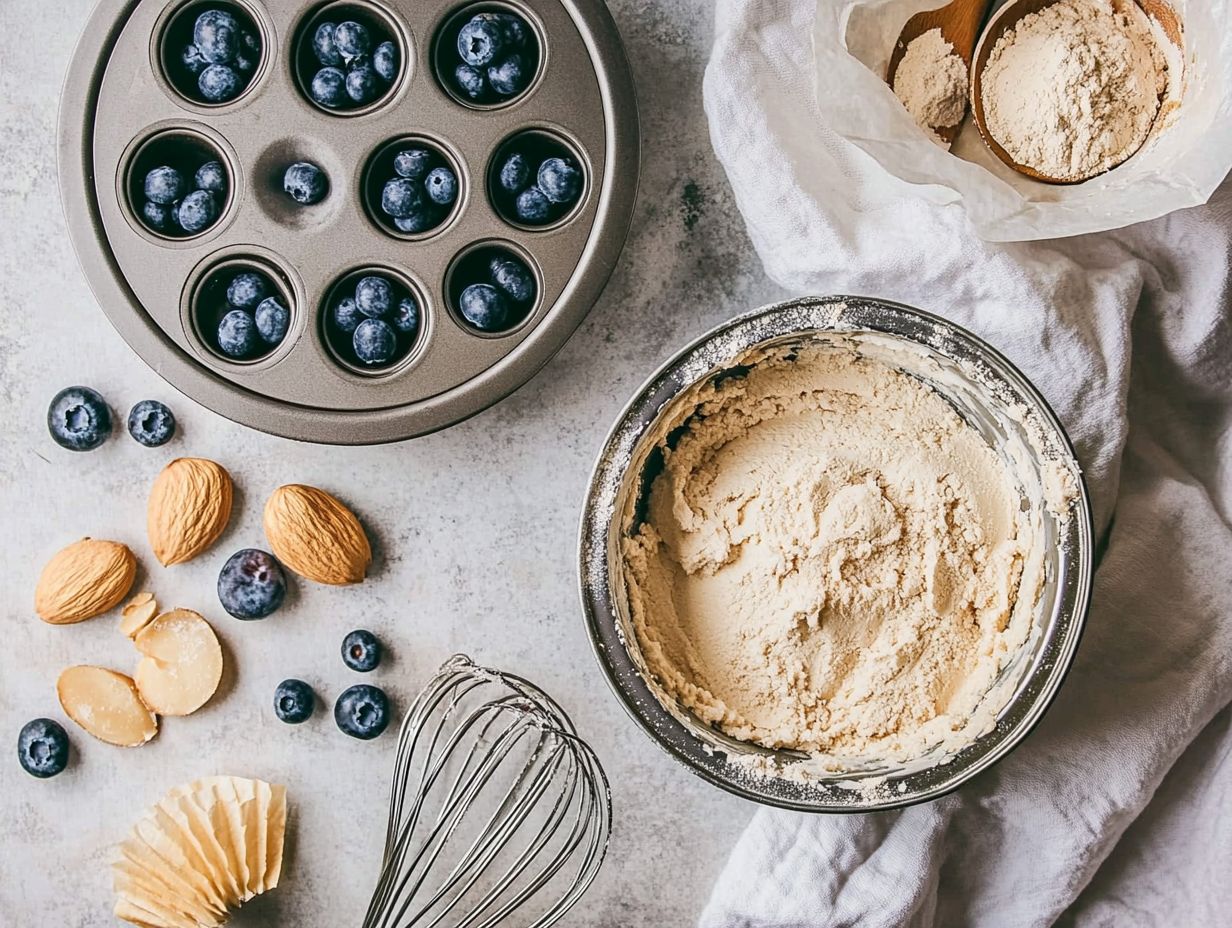
Proper storage and reheating techniques are crucial for preserving the freshness and delightful taste of your gluten-free muffins. Once you ve let the muffins cool on a rack, make sure to transfer them to an airtight container. This simple step will keep them moist and flavorful, ensuring that each bite remains enjoyable for days after baking.
What Is the Best Way to Store Gluten-Free Muffins?
To keep your gluten-free muffins fresh for as long as possible, it is essential to store them in an airtight container. Depending on when you plan to indulge in them, you can also choose to refrigerate or freeze the muffins. This will prolong their shelf life while preserving their delightful flavor and moisture.
Refrigerating your gluten-free muffins is a smart move if you anticipate enjoying them within a few days. This method helps slow down mold growth and retains moisture. However, refrigeration might slightly alter the texture. This can make the muffins slightly denser.
For longer storage, freezing is an excellent strategy. By wrapping each muffin tightly in plastic wrap and placing them in a freezer-safe bag, you can maintain their delicious taste for several months.
When you’re ready to indulge, don’t wait any longer! Simply thaw it at room temperature or pop it into the microwave for a quick warm-up. Both methods ensure that you can savor your baked goods without compromising on quality.
How to Reheat Gluten-Free Muffins?
Reheating gluten-free muffins is a simple task. You can easily reheat them in a microwave or an oven, depending on what you prefer. If you’re in a hurry and need a quick option, just pop the muffin in the microwave for a few seconds. However, if you re after that delightful, just-baked quality, the oven is your best bet.
Microwaving is incredibly convenient, especially when time isn’t on your side; it typically takes only about 10-20 seconds to warm up. Just keep in mind that this method can sometimes leave you with a slightly soggy or unevenly heated muffin. In contrast, using the oven takes longer but provides better results around 5-10 minutes at a low temperature. The oven guarantees a crispy exterior paired with a soft, warm interior, truly reviving that fresh-baked experience.
Ultimately, the decision between these methods comes down to whether you value speed or quality in your reheated delights.
Troubleshooting Common Problems with Gluten-Free Muffins
Baking gluten-free muffins can present a unique set of challenges. However, with an understanding of the common pitfalls, you can elevate your results significantly. If your muffins are turning out dry, crumbling apart, or not rising as they should, pinpointing the solutions to these issues will refine your baking skills.
Embracing these insights will ensure a more rewarding experience in your gluten-free muffin journey. You’ll achieve delightful outcomes that you can truly enjoy.
Why Are My Muffins Dry?
Dry gluten-free muffins can often be the result of several factors, such as not measuring correctly, insufficient moisture, or overbaking. To prevent this baking mistake, ensure that you re measuring your gluten-free baking flour accurately and incorporating ample wet ingredients. Adjust the baking time as needed to maintain moisture and flavor.
Think carefully about the type of gluten-free flour you choose. Blends typically deliver superior results compared to single varieties. A mix of almond flour or coconut flour can significantly boost moisture levels. Adding ingredients like applesauce or yogurt can enhance the texture even further.
Pay close attention to the baking process, as oven temperatures can vary widely. A simple toothpick test can be your best friend; remove the muffins when they re just set and a few moist crumbs cling to the toothpick.
By adopting these thoughtful strategies, you can create fluffier, more satisfying gluten-free muffins that will delight both you and your family.
Why Are My Muffins Falling Apart?
If your gluten-free muffins are falling apart, it likely points to issues with the structure and binding agents in your recipe. Ensuring you incorporate the right ingredients, such as xanthan gum or another binding agent, can significantly enhance your muffins’ structure and keep them from crumbling when you handle them.
The choice of flour is also pivotal to achieving the perfect texture, as some gluten-free flours are more absorbent than others. For example, blending almond flour with coconut flour creates a delicate balance, helping to retain moisture while providing the stability your muffins need.
In addition, adding ingredients like applesauce or yogurt can increase moisture levels, improving the overall consistency. It s also essential to pay attention to baking time and temperature; undercooked muffins have a greater tendency to fall apart.
By fine-tuning these various elements, you ll be well on your way to crafting scrumptious, cohesive gluten-free muffins that not only taste great but also have a delightful texture.
Why Are My Muffins Not Rising?
Muffins not rising? You re not alone this is a common hiccup in gluten-free baking, often caused by inactive leavening agents or incorrect oven temperatures. To achieve those coveted tall muffin tops, it s essential to ensure your baking powder and baking soda are fresh and properly mixed with the wet ingredients. Also, don t forget to preheat your oven to the correct temperature before you start baking.
Another crucial factor in the rise of your gluten-free muffins is the flour blend you choose. Different gluten-free flours come with varying absorption rates and protein contents, which can dramatically affect the muffins’ structure. Opt for a gluten-free flour blend that includes xanthan gum or another binding agent to mimic the elasticity of gluten, allowing your muffins to rise beautifully.
Incorporating room temperature ingredients is also key to achieving a smooth batter, ensuring even distribution and optimal rise. Remember to avoid overmixing the batter; otherwise, you may end up with dense muffins instead of the light, fluffy texture you re aiming for.
Frequently Asked Questions
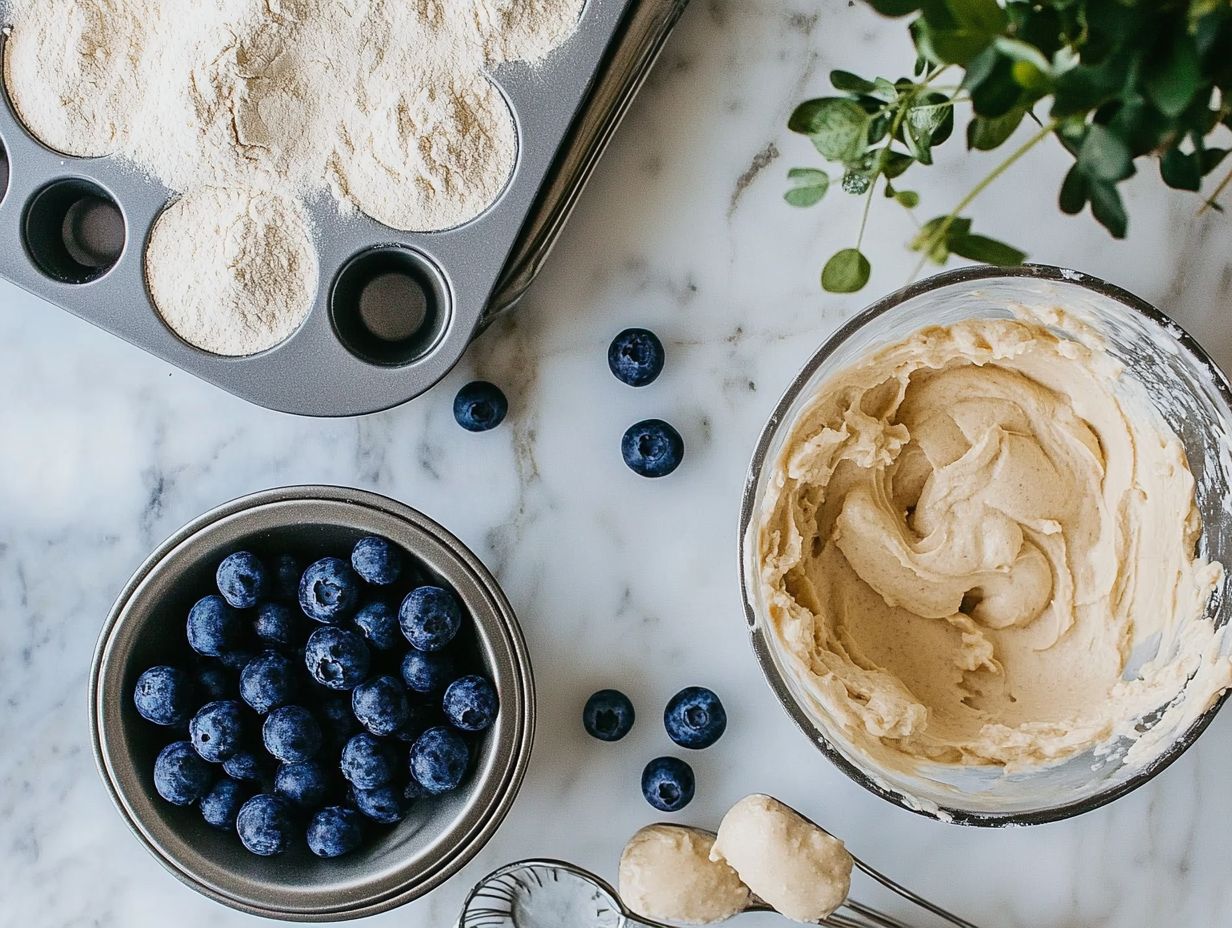
What are the benefits of using gluten-free ingredients when baking muffins?
Using gluten-free ingredients allows individuals with celiac disease, gluten intolerance, or those following a gluten-free diet to enjoy delicious muffins without any negative side effects.
What are some common substitutes for wheat flour in gluten-free muffin recipes?
Some common substitutes include almond flour, oat flour, coconut flour, and gluten-free baking mixes. It’s important to read the labels and make sure the substitute is truly gluten-free.
How can I ensure that my gluten-free muffins turn out moist and fluffy?
To prevent dry and dense muffins, try adding a bit of unsweetened applesauce, mashed bananas, or a small amount of yogurt to the batter. This will add moisture and help the muffins rise.
Can I use regular muffin recipes and simply substitute gluten-free flour?
In most cases, substituting regular flour with gluten-free flour will not yield the same results. It’s best to follow a specific gluten-free muffin recipe that has been tested and perfected for best results.
How important is it to use gluten-free baking equipment and utensils?
If you have celiac disease or a severe gluten intolerance, it’s important to use separate baking equipment and utensils to avoid any cross-contamination. This includes mixing bowls, measuring cups, and even baking trays.
Are there any add-ins or toppings that pair well with gluten-free muffins?
Yes, there are many delicious add-ins and toppings that can enhance the flavor of gluten-free muffins. Some popular choices include fresh berries, chocolate chips, nuts, and streusel toppings.



